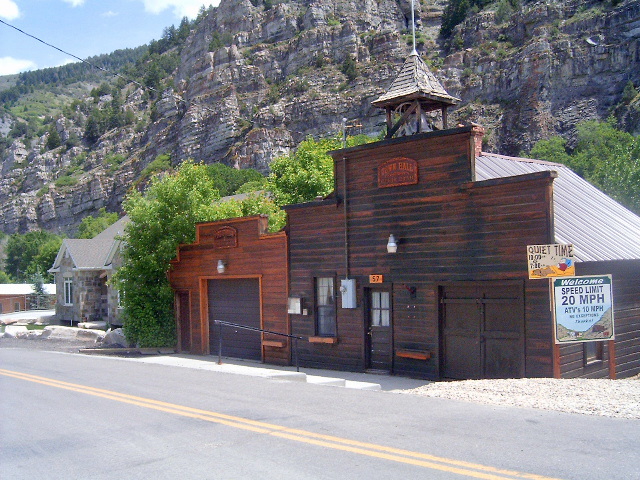

- CATEGORIES
A Brief History of Ophir City

Original Ophir City Hall. Photo courtesy of W. David Samuelsen
Introduction
by Jennifer D. J. Banks
Before white settlers came to inhabit the Rush Valley
area, it was sparsely inhabited by the Goshuite Indians. The
Gosuites, a branch of the Shoshone Tribe, were poor
hunter-gatherers. However they did have some shot and ornaments
made of silver that they had been able to mine from exposed ore.
In the 1860s, off-duty soldiers encouraged by their commanders,
began to engage in prospecting in the mountains of northern Utah.
Some of these men became aware of the silver possessed by the
Indians in the area and persuaded the Indians to show them where
the ore had come from. This led them to East Canyon in the Oquirrh
Mountain Range.
Prospecting and small scale mining in East Canyon began
sometime during the late 1860s. The canyon was renamed Ophir after
the Ophir in the Bible where King Solomon got his gold and silver.
On August 6, 1870, the Ophir Mining District was organized in
Ophir City. On the 23rd of August in 1870 the first mining claim
in the Ophir District was made. It was called Silveropolis.
Like many boom towns, Ophir began to grow rapidly. By
1871, Ophir City boasted 125 businesses and houses, a school, and
a post office. Also in 1871, the first stamp mill in Utah began
operations in Ophir. The Pioneer Stamp Mill was owned by the
Walker Brothers, who were merchants in Salt Lake City, and it
pounded out thirty tons of treasure a day. By 1874 there were
three stamp mills, four arrastras (ore reducing mill
stones) and two smelters operating in Ophir Canyon.
A listing of all the mines in operation in 1874 shows
that many of them were owned by private companies. The mining
newspapers of the time make constant reference to the need for
good workers to work these mines. One of the agents for Walker
Brothers, Marcus Daley, purchased a mine for himself and made
enough money from it to buy the Anaconda Mine in Butte, Montana.
This later made him one of the two top Copper Kings.
Most of the ore taken out of Ophir was lead, silver, and
zinc with copper impurities. There wasn't much gold. From 1870 to
1900 only $329,000 in gold was taken out compared with $13,000,000
in silver and base metals. One shipment of silver bullion from the
Pioneer Mill in April of 1874 was worth $64,583.
Unlike many mining towns however, Ophir did not die.
Smaller scale mining continued on into the next century. Most
mining was done by small partnerships and family operations. Those
who remained worked in the mines and raised their families. The
city government, post office, and school remained in operation.
community activities began to replace the saloons. The city was
host to an IOOF Lodge, and the local baseball team was a source of
much pride. There were also dances and other socials to keep the
young people entertained.
Ophir escaped the fate of a Ghost Town. There continues
to be a small community there comprised of a dozen or so permanent
residents along with some summer homes.